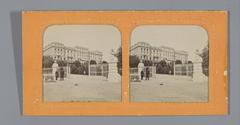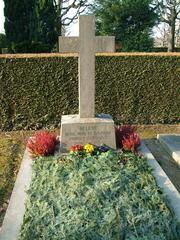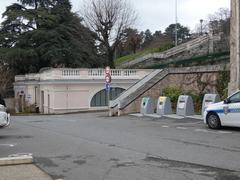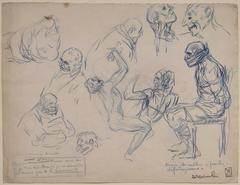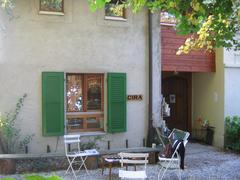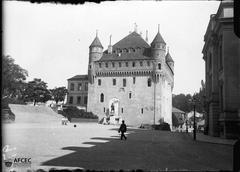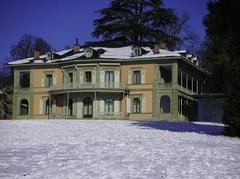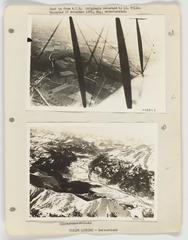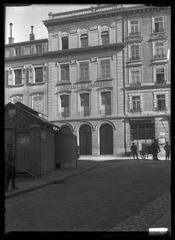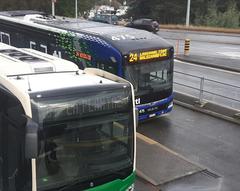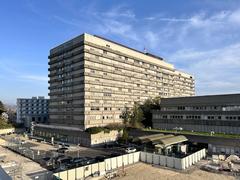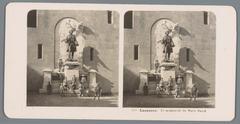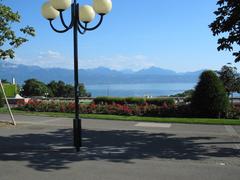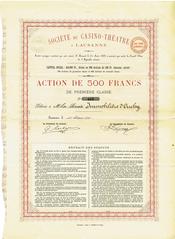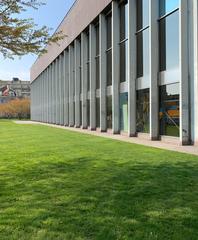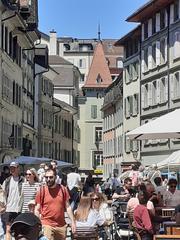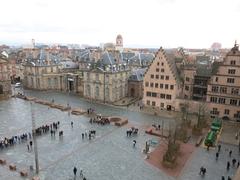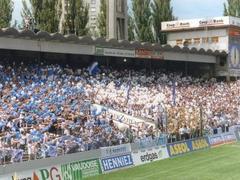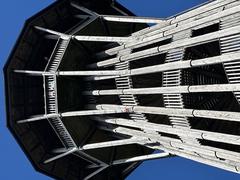Château de Vidy: Visiting Hours, Tickets, and Historical Sites in Lausanne
Date: 03/07/2025
Introduction: The Significance of Château de Vidy in Lausanne
Château de Vidy, located on the tranquil shores of Lake Geneva in Lausanne, Switzerland, is an emblem of the city’s layered history, architectural evolution, and global cultural relevance. Though the château currently serves as the headquarters of the International Olympic Committee (IOC) and is not open for public tours, its surrounding parklands, Roman Museum, and archaeological sites make it a compelling destination for visitors. The area’s roots stretch back to the ancient Roman settlement of Lousonna, with ongoing excavations revealing villas, baths, and early Christian structures—offering a tangible link to Europe’s distant past (Musée romain de Lausanne-Vidy).
Constructed in the 18th century as a neoclassical residence, Château de Vidy stands as a testament to Enlightenment principles of symmetry, harmony, and integration with nature. Its transformation into the IOC’s base in 1968 solidified Lausanne’s status as the “Olympic Capital” (lausanne.ch). Today, visitors can explore the adjacent Roman Museum, the serene English-style parklands, and enjoy lakefront activities, immersing themselves in Lausanne’s remarkable story (lausanne-tourisme.ch).
This guide offers a detailed overview of Château de Vidy, including its historical journey, architectural highlights, visitor access, nearby attractions, and practical tips to ensure a memorable visit.
Table of Contents
- Historical Overview
- Visitor Information
- Architectural and Archaeological Features
- Practical Tips and Nearby Attractions
- Frequently Asked Questions (FAQs)
- References and External Resources
Historical Overview
Roman Origins and Early Christian Heritage
Château de Vidy is built atop the ruins of Lousonna, a thriving Roman settlement active between the 1st and 4th centuries CE. Archaeological discoveries in the area—including villas, baths, a forum, and Switzerland’s earliest known Christian church—underscore the site’s strategic and cultural importance (swissactivities.com). These layers of history are visible in both the museum’s collections and the château’s foundations.
Enlightenment and Architectural Evolution
The present château was constructed in the 1760s, commissioned by Jean-Jacques de Sellon, a member of Lausanne’s nobility. Designed in the neoclassical style, it features symmetrical layouts, refined façades, and integration with the surrounding landscape. Over subsequent centuries, the estate was enhanced with English-style gardens and outbuildings, preserving much of its 18th-century character (Swiss Castles).
Modern Olympic Era
In 1968, the IOC established its headquarters at Château de Vidy, selecting Lausanne for its neutrality and welcoming spirit. The château underwent further restoration to accommodate its new role, and in the 21st century, the sustainable Olympic House was added, connected to the historical structure by a transparent corridor (Architectes.ch). The site remains a symbol of international cooperation and sporting excellence.
Visitor Information
Park and Museum Access
- Château de Vidy (IOC Headquarters): Not open to the public.
- Parklands: Open year-round from sunrise to sunset. Visitors can enjoy lakeside walks, cycling, picnics, and scenic views.
- Roman Museum of Lausanne-Vidy: Open Tuesday to Sunday, typically from 10:00 or 11:00 AM to 5:00 or 6:00 PM. Closed on Mondays except during peak periods (Musée romain de Lausanne-Vidy).
Tickets, Hours, and Accessibility
- Park and Promenade: Free, no tickets required.
- Roman Museum: Adult admission approximately CHF 10, with discounts for students and seniors. Tickets are available onsite and online.
- Accessibility: The park, promenade, and museum are wheelchair accessible, with paved paths and ramps.
Events and Guided Tours
Public events—such as open-air concerts, art exhibitions, and historical lectures—are held in the park and at the museum, especially in summer. The museum offers guided tours and educational activities for all ages (lausanne-tourisme.ch).
Architectural and Archaeological Features
Key Elements of the Château
Château de Vidy features neoclassical proportions, original 18th-century wood paneling, ornate fireplaces, and period decorative motifs. Though the interior is not accessible to the public, the exterior façade and manicured gardens offer a glimpse into Enlightenment-era Swiss architecture (Swiss Castles).
Roman Remains and Archaeological Park
The adjacent archaeological park showcases the remains of Roman Lausanne, with interpretive signage and the foundations of ancient villas and public buildings. The museum’s exhibits include mosaics, coins, ceramics, and daily objects from the Roman era, providing context for the site’s ancient roots (Musée romain de Lausanne-Vidy).
Integration with Modern Olympic House
The innovative Olympic House, constructed with sustainable materials and connected by a glass corridor, symbolizes the fusion of historical legacy and contemporary design (Architectes.ch).
Practical Tips and Nearby Attractions
Getting There and Facilities
- Transport: Easily accessible by Lausanne public buses (lines 2, 4, 8, 24), with stops near the park and museum. Dedicated cycling paths lead from Ouchy and central Lausanne (lausanne-tourisme.ch).
- Parking: Limited public parking is available; consider public transport during peak times.
- Amenities: Onsite restrooms, changing facilities near beaches, picnic tables, playgrounds, and seasonal cafés.
Lakeside Activities and Festivals
The Vidy lakeside area offers swimming, sunbathing, sailing, stand-up paddleboarding, and birdwatching in the adjacent wetlands. The park hosts open-air concerts, summer festivals, and community events, providing opportunities to experience local culture.
Recommendations for a Memorable Visit
- Timing: Visit in spring or summer for vibrant gardens and lakeside activities; early mornings or late afternoons offer ideal light for photography.
- Combining Attractions: Pair your visit with the Olympic Museum, Lausanne Cathedral, or the Lavaux vineyards for a full day of exploration (onedayitinerary.com).
- Accessibility: The site is suitable for wheelchairs and strollers.
- Respect Local Customs: Maintain cleanliness and quiet in the park, especially during evenings.
Frequently Asked Questions (FAQs)
Q: Can I visit inside Château de Vidy?
A: No, the château is not open to the public as it serves as the IOC headquarters.
Q: Are there tickets required for the park or museum?
A: The park is free to access. The Roman Museum charges an admission fee; check the official website for current rates.
Q: Are there guided tours available?
A: Guided tours are offered at the Roman Museum and for the archaeological park.
Q: Is the area wheelchair accessible?
A: Yes, paved paths and ramps facilitate access throughout the park and museum.
Q: What is the best time to visit?
A: Spring and summer offer the most outdoor activities and events; autumn provides peaceful scenery.
Q: How do I reach Château de Vidy?
A: Use Lausanne’s public transport or cycle along the lakeside paths; parking is available but may be limited.
References and External Resources
- Swiss Activities: Discover Château de Vidy
- Lausanne Official Website: Olympic Capital
- Swiss Castles: Château de Vidy
- Architectes.ch: Maison Olympique
- MySwitzerland.com: Musée romain de Lausanne-Vidy
- Lausanne Tourism
- SwitzerlandIsYours: Historical Background of Lausanne
- StudyingInSwitzerland.com: Things to Do in Lausanne
- One Day in Lausanne Itinerary
Plan Your Visit
Château de Vidy is a unique window into Lausanne’s ancient and modern identity. While interior tours are not available, the parklands, Roman Museum, and archaeological park offer enriching experiences for every visitor. For the latest updates on museum hours, special events, and digital resources—including virtual tours and interactive maps—visit the official tourism and museum websites.
Download the Audiala app for personalized guides, event updates, and insider tips. Share your experience using #ChateaudeVidy and explore more about Lausanne’s top historical sites and lakeside attractions.
